|
|
July 12th, 2007
Thanks to Adam Braverman of Nammo Lapua, Zak Smith had a chance to test out the new Lapua 6.5×47 123gr factory ammo recently in his Accuracy Int’l tactical rifle. Zak reports: “Accuracy was excellent–the ammo shot as tight as I could hold in the windy conditions. This ammo is half-MOA or better, easy. When I did my job, all shots were touching at 100 yards. The ammo fed from my AI magazine perfectly–no problems at all. It seems the ammo is loaded pretty mild. From a 25.3″ barrel, velocity was 2820 fps over my chronograph. This compares with 2790 fps claimed by the factory from a 26″ barrel (see chart below). That 30 fps is easily within barrel to barrel variation (or chrono variation for that matter). So, consider the 123gr 6.5×47 ammo a 2800 fps product. With this 123gr factory load, there were no pressure signs–primer edges were round, there was no significant cratering, and case-head growth was minimal.”

Larger Chart (English Data) | Larger Chart (Metric Data)
Zak added: “Overall, I was very impressed with this ammo. Accuracy, on the test day, was actually a bit better than my handloads–but it was pretty windy. This stuff is definitely ‘good to go’ for someone who doesn’t reload and wants quality 6.5mm ammo for a tactical match. You won’t have the velocity of a ‘max’ handload, but even at 2800 fps, given the .547 BC of the 123gr Scenar, this ammo easily beats a .308 shooting 175s in terms of long-range ballistics. The chart below shows comparative drift in a 10 mph wind at 600 and 1000 yards.”
| Cartridge |
FPS |
BC |
600yd Wind |
1000yd Wind |
| 6.5×47 123gr Scenar |
2800 |
0.547 |
23.53″ |
75.34″ |
| .308 175gr SMK |
2700 |
0.496 |
28.12″ |
90.95″ |

Share the post "6.5×47 Lapua Factory Ammo Field Test"
July 12th, 2007
We chatted with German Salazar of Shooters Journal at a rimfire match this weekend (which he won). German reminded us that he had done a comparison review of the Jewell and Kelbly. Here is German’s report:
“I received one of Kelbly’s new triggers and installed it on my 6BR Remington 40X. Installation was normal for any Rem-pattern trigger and it fit perfectly. However, the stock (previously inletted for a Jewell trigger), required a slight amount of material removal at the front of the trigger slot as the Kelbly trigger is a bit longer than a Jewell.

Construction of the Kelbly is very robust. It appears to be machined from a solid bar of steel rather than being two end plates screwed together. Perhaps the trigger’s best feature, however, is very wide range of pull-weight available with no changing of springs or other parts. As delivered it was set for approximately 1.5 oz. and broke very cleanly at that weight. Since my application is 300 Meter prone shooting, I raised it to 6 oz. This required moving a pin under the sear bar to the second of four holes and slightly tweaking the weight of pull screw. Compared to other triggers, it was a joy to work with this arrangement and took just a couple of minutes. All adjustments (weight of pull, over-travel, and sear engagement) are made with set screws and their effect on the internal parts can be seen through windows cut into the trigger body. This makes trigger tuning more precise.
On the downside, the barreled action must be removed from the stock to perform the adjustments (unless you use a trigger hanger), but that’s a small price to pay for the overall quality and ease of adjustment. At my current setting of 6 oz. and no over-travel, the trigger breaks like ice. I couldn’t ask for more. Kudos to the good folks at Kelbly’s–they have another winner here.”
Share the post "Kelbly and Jewell Triggers Compared"
July 11th, 2007
This week, ShootingUSA (hosted by Jim Scoutten) features the 2006 NRA High Power Silhouette Nationals, filmed at the Ridgway Rifle Club in Pennsylvannia. High Power Silhouette is one of the most challenging (yet rewarding) of centerfire disciplines. While standing, silhouette shooters try to hit lunch-box-sized metallic Rams, Turkeys, Pigs and Chickens at distances up to 500 meters. Scoring is simple–the target either falls or it doesn’t. Most competitors use 20- to 36-power scopes. Big scopes make it easier to see the targets, to be sure, but only if you can maintain a super-steady hold. If you think it’s easy… just try holding on a 12″ bullseye at 100 meters with a 30-power scope from a standing position. Chances are your scope picture will be dancing all over the target–and that’s only at 100 meters, not 500.

In High Power Silhouette, competitors alternate shooting and spotting for each other. The spotter calls wind and mirage, while keeping tracking of time during each 2.5-minute, 5-shot relay. Choice of calibers–you need a round with enough energy-on-target to knock down the big rams at 500 meters. At the same time you want to maximize accuracy and minimize recoil. Right now the “sweet spot” seems to be a 130-160 grain bullet moving at least 2650 fps. Favored chamberings include .260 Remington, 7mm-08 and 7mmBR. (A few guys have tried 6BRs, but 100gr 6mm bullets won’t reliably take down the 500m rams).

This Shooting USA episode on the Outdoor Channel features many of the nation’s top centerfire silhouette marksmen. It’s a rare treat to see this kind of precision rifle shooting on television. Broadcast times for Wednesday, 7/11/2007 are: Eastern Time – 5:00 PM, 9:00 PM and 1:00 AM; Central Time – 4:00 PM, 8:00 PM and 12:00 Midnight; Mountain Time – 3:00 PM, 7:00 PM and 11:00 PM; Pacific Time – 2:00 PM, 6:00 PM and 10:00 PM. (Check local listings for repeat showings.)
Share the post "High Power Silhouette On ShootingUSA TV"
July 11th, 2007
Shooters who convert factory actions to run 6BRs or 6PPCs should consider having the firing pin bushed. These small-cased cartridges like to run at high pressures. When running stout loads, you can get cratering caused by primer flow around the firing pin hole in the bolt face. The reason is a little complicated, but basically the larger the hole, the less hydraulic pressure is required to crater the primer. A limited amount of cratering is normally not a big issue, but you can reduce the problem significantly by having a smith fit a bushing in the firing pin hole. In addition to reduced cratering, bushing the firing pin often produces more consistent ignition.
This is a highly recommended procedure that our editors have had done to their own rifles. Greg Tannel (Gre-Tan Rifles) is an expert at this procedure, and his turnaround time is fast–usually 1-3 days (shop time). Current price for a bushing job, which includes turning the firing pin to .062″, is $60 including return shipping.

If you have a factory rifle, a bushed firing pin is the way to go if you are shooting the high-pressure cartridges such as 6PPC, 6BR, and 6.5×47. This is one of the most cost-effective and beneficial upgrades you can do to your factory rifle.
Share the post "Bushing Firing Pin Holes for Less Cratering, Better Ignition"
July 10th, 2007
Many shooters and hand-loaders lack a clear understanding of certain elements of bullet design. While most serious shooters know that Secant and Tangent Ogive bullets are different, many of us would have trouble explaining the precise nature of the difference. Thankfully, Dan Lilja clarifies this and many other bullet design matters in his excellent article, Calculating Bullet Weights. Here’s the straight scoop on bullet ogive differences, in Dan’s words:
“Spitzer bullets all fall into one of several different design types. A bullet’s geometry can be broken down into symmetrical sections. The body (or shank) of the bullet is that part of the bullet that comes into full contact with the barrel rifling. It is the cylindrical portion of the bullet of nominal groove diameter for that caliber. It is also referred to as the Bearing Surface.
The term “Ogive” is commonly used to describe that specific point where the curving part of the bullet nose begins–i.e. where the bearing surface ends and the curved part begins. When we talk about “bearing surface length”, this is the distance from the top of the boattail to the point where the bullet starts to curve.

However, the terms “ogive” or “ogive profile” are also used to describe the entire forward curved section of the bullet, ahead of the bearing surface. The Ogive Profile, or nose of a bullet, can be one of three varieties, two being common*. The ogive can have a tangent radius; that is, the intersection of the body of the bullet and the radius of the ogive blend together at a tangent point. This is the most common type and is typical of most bullets handloaders use. The other common type is the secant ogive. In this case the intersection of the ogive and bullet body does not flow together smoothly. The point of intersection is not tangent, the ogive radius being a secant of the arc circle of the ogive.
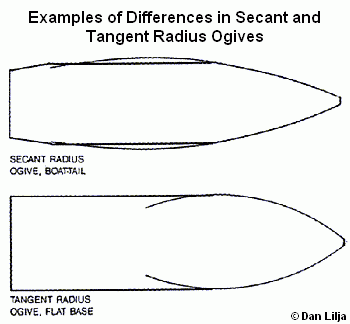
The radius of the ogive is generally given as a multiple of the bullet diameter. For example, a 30-caliber bullet might have a 7-caliber tangent ogive. That is to say that the radius, in inches, is seven times .308 or 2.156 inches. When a bullet is described as “7 Ogive” this is what is meant–the radius of the bullet’s nose section as a multiple of the bullet diameter. (A “7 Ogive” can be any caliber, not just 30 caliber–it is the ratio of the curve radius to diameter that counts).
The point or tip of the ogive is called the Meplat. This can vary in diameter from about .050″ to over 0.125″ for conventional spitzer-type bullets.
The base of the bullet can be either a boattail shape or flat base. If a boattail, its shape is determined by the axial length of the boattail and the angle at which the boattail leaves the body of the bullet.”
*The third bullet nose type is a cone. Cone-shaped bullets are not common with handloaders, but some experimental work is done with them.
Share the post "Bullet Design–Secant vs. Tangent Ogive"
July 10th, 2007
RELOADING TIP: Andris Silins has come up with a simple way to measure length to the lands in your rifle:
“Here’s what I did to find length to lands for seating my bullets. I made four cuts into the neck of fire-formed brass. Then I pressed the bullet in lightly and chambered the entire gauge. As the cartridge chambers, the bullet slides back into the case to give you length to lands. It took less than five minutes to get it cut and working. A little light oil in the barrel just past the chamber helps ensure the bullet does not get stuck in the lands. It works great and is very accurate.
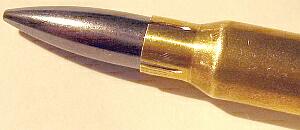
I made the cuts using a Dremel with a cut-off wheel. You can adjust tension two ways. First, you can make the cuts longer or shorter. Longer cuts = less tension. If you used only three cuts insted of four you would get more tension. The trick is to be gentle when you open and close the bolt. If you ram the bolt closed you may wedge the bullet into the lands. When you open the bolt it helps to keep a finger or two near by to guide the case out straight because the ejector wants to push it sideways.”
Share the post "Easy, Economical Length-to-Lands Gauge"
July 9th, 2007
Tom Sarver has entered the ranks of the Immortals. Shooting at the Thunder Valley (Ohio) Range on July 7th, Tom nailed a truly spectacular 1.403″ 5-shot group at 1000 yards. This represents a new IBS Light Gun group-size record that edges Rich DeSimone’s 1.564″, previously thought “untouchable.” What is even more amazing is that the group was centered, producing a 50-score with 5 Xs. That will be a new IBS Score record as well.
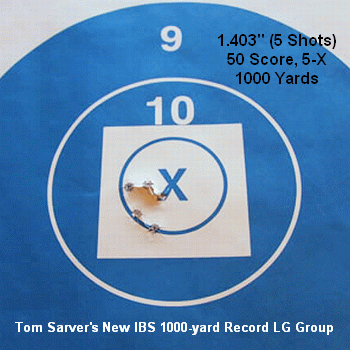

Tom was shooting a big 30 wildcat he calls the “300 Hulk”, a shortened 338 Lapua Magnum necked down to 30 caliber, pushing 240gr Sierra MatchKings (0.711 BC) at close to 3000 fps. Tom is using about 85 grains of H1000. He anneals the Lapua brass after every firing, and the brass that set the record was on its 58th firing! After the record Group/Score target on Relay One of Match 7 in the Ohio 1000-yard series, Tom added a 6″ group that secured the Light Gun class victory according to fellow Thunder Valley shooter Dan Wassum. Dan also notes: “Tom has been very close several times to records, but this time all five were in the right spot.” (J.P. Lucas was the 2007 Ohio Overall Two-Gun Champ at Thunder Valley this year.)
Rich DeSimone offered his congratulations to Tom: “Congratulations from the guy you ‘de-throned’. It could not happen to a nicer more deserving guy. Since I have known you, when you first started shooting benchrest at Hawk’s Ridge with a bi-pod and a .308 snipers rifle, you have come a VERY long way. This August 17th would have been five years since I beat the existing record by around .040″ and now you blew mine away by about .160″ and put five X’s with it to boot. Way to go Tom!”
Share the post "Sarver Shoots 1.403" Group at 1000 Yards"
July 8th, 2007
Stephen Ivey has engineered an interesting set of gimbaled scope rings allowing up to 150 Minutes of Angle (MOA) of elevation. These rings have precision hinge pins front and rear allowing the entire scope to be tilted by a micrometer-controlled cam in the rear. This allows the scope to tilt upwards (in the rear) with the front ring as the axis while both rings remain parallel to prevent scope binding. The rear ring tilts to match the front while a cam pushes it up. Ivey also makes tilting +150 MOA Picatinny riser rails.

Ivey offers three scope-mounting products. First is the BR 30-50 (above). This has two, polished 30mm 6061-T6 aluminum rings with bases to fit a 1/2″ x 60 degree Stolle (Davidson) rail on top of an action. Total elevation is +50 MOA. The micrometer adjuster is graduated in true 1 MOA intervals, with 5 MOA of elevation change per rotation. This product costs $385.00 and requires at least 5-1/2″ length mounting base. Available in either “bright” or satin finish.

The newest product is the MSRR-150MOA Riser Rail, a pivoting 5.75″-long Picatinny-style rail that accepts Weaver-style clamping scope rings. This Adjusts from Zero to +150 MOA and raises the scope 1.45″ from the top of the action. The extra height provides clearance for large objectives when the unit is tilted for a full +150 MOA elevation. Cross slots are 5mm wide at 10mm (.394″) spacing. The $425 riser rail is made 6061 T6 Aluminum hard-anodized black. Clamps are heat-treated steel. The micrometer thimble is marked for 1 MOA gradations, and provides 20 MOA per revolution.

The third product, the $445 MSR 30-150, has a pair of 30mm clamping rings that fit on a Picatinny-style (1913 mil-spec) rail. Base cross-slots for two-bolt clamp can accomodate 3/4″ to 1″ slot spacing between centers. Height from top of rail to center of rings = 1.82″ at lowest setting. Note: you need a rail at least 5.625″ long.

The Ivey products are expensive, to be sure, but they are beautifully machined, and they offer unique capabilities for ultra-long-range shooters. With the +150 MOA units you have enough elevation to shoot at 2000+ yards! Even with the +50 unit you can you shoot at 1000 while keeping your scope centered in its elevation travel. We like the idea of using the micrometer to dial within 1 MOA and then just using the scope turrets for fine-tuning. To learn more, visit the Ivey Shooting website, or call Stephen Ivey at (615) 424-8855.
Share the post "External Adjusting Rings and Rails for Ultra-Long-Range Shooting"
July 7th, 2007
AccurateShooter.com reader Birgir Saemundsson from Iceland has created some very nice Benchrest videos, which can be viewed on Google Video. Produced in association with Icelandic Television, the short videos show the whole process of shooting–in an outdoor environment that can only be described as “wild and natural”. Birgir had cameras placed close to the target, so you can actually see a 5-shot group form up, shot by shot. If you’ve never shot sub-quarter MOA before, watch these videos and see how it’s done.
Video 1 (6 min. Intro to Benchrest)
Video 2 (2 min. Shooting and Interview)
Below is an animation we’ve composed from frames in the videos showing H.S. Myndatökur shooting a 6PPC at 100m. Nice shooting, young lady!
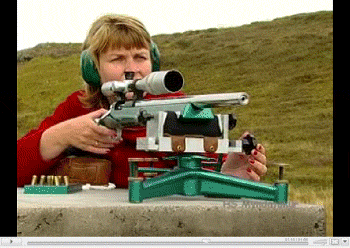
And here is Birgir Saemundsson shooting his Heavy Gun. Note the muzzle flash:

Share the post "Iceland Benchrest Shooting Videos"
July 7th, 2007
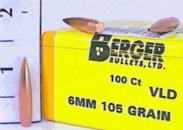 Now through the end of July, 2007, MidwayUSA has Berger 105gr VLD bullets on sale. The sale price is $19.99–that’s $6.50 under the regular $26.49 price. While MidwayUSA won’t guarantee specific lot numbers, all of the 105 VLDs (item 195087) that MidwayUSA has been shipping lately have been produced on the new die. So if it’s “new die” Bergers you want, here is a good source. Most user reports on these bullets have been very positive. NOTE: this is a secant ogive bullet that will probably work best seated into the lands. Now through the end of July, 2007, MidwayUSA has Berger 105gr VLD bullets on sale. The sale price is $19.99–that’s $6.50 under the regular $26.49 price. While MidwayUSA won’t guarantee specific lot numbers, all of the 105 VLDs (item 195087) that MidwayUSA has been shipping lately have been produced on the new die. So if it’s “new die” Bergers you want, here is a good source. Most user reports on these bullets have been very positive. NOTE: this is a secant ogive bullet that will probably work best seated into the lands.
Share the post "Berger 105 VLDs on Sale–$19.99/100"
July 6th, 2007
There has been considerable interest in an “improved” 6BR case that retains a longer neck than the Dasher. David Stripling has his 6BR-DX (shown below), with a 40° shoulder and about 2 grains extra capacity. Another wildcat in this mode is the new “6mm BRG”. On Benchrest.com, Plugger posted: “I am now shooting a 6mm BRG. This round was developed by three long range shooters and is based on the 6BR case as is the Dasher. It gives you more capacity than the straight 6BR but a longer neck than the Dasher which should give better barrel life. It is an extremely accurate round that I shoot in 600 and 1000 comp. If you have any interest in this cartridge then talk to Billy Dale of BDR Custom Rifles, (804) 314-6787. Billy was one of the developers of this round and is an excellent gunsmith to boot.”

The 6 BR-DX (0.283 Neck)
The 6BR-DX is an improved version of the 6mm BR Norma cartridge, with a 40° shoulder and a bit less body taper than a Dasher. The shoulder is .462″ (just a couple thousandths bigger than a standard case) and the diameter at the web is .470″. 6BR-DX water capacity is about 39.5 grains. That’s about 1.5-2.0 grains more than a standard 6BR case, depending on your chamber. With the extra boiler room provided by the BRDX, David Stripling can stuff 34+ grains of RL15 into the 6BR-DX, even though the neck, at 0.283″, is just .039″ shorter than a standard BR. With the added capacity, David can launch Berger 88s at nearly 3300 fps, or Berger 95s at 3200 fps.
Share the post "New "Short Dasher": The 6mm BRG"
July 6th, 2007
On July 20-22, the NBRSA 1000-yard Nationals will be held at the Palamino Range just outside Reno, Nevada. Competitors will shoot both Light Gun (17-lb max) and Heavy Gun (Unlimited) Classes. The format is SIX targets each day if you shoot two (2) classes, or THREE targets each day if you are shoot one (1) class. Friday the 20th is a sign-up, weigh-in, and practice day. If you need to shoot to practice or zero, there is a $10.00 range fee on Friday. For the match, the Entry Fee is $20 per day per gun.

You can still register and compete. However, pre-registration was required 30 days before June 20th. A $40 late fee will be applied for late registration. Match is July 21st and 22nd. Local information and Registration Form are found on the Palomino Valley Gun Club website. For more info contact Bob Hoppe at (775) 397-3358.
Share the post "NBRSA 1K Nationals July 20-22 (Reno, NV)"
|





























 Now through the end of July, 2007,
Now through the end of July, 2007, 






